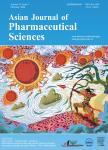Redox-responsive biocompatible nanocarriers based on novel heparosan polysaccharides for intracellular anticancer drug delivery
Redox-responsive biocompatible nanocarriers based on novel heparosan polysaccharides for intracellular anticancer drug delivery作者机构:School of Pharmaceutical SciencesJiangnan UniversityWuxi 214122China Wuxi Higher Health Vocational Technology SchoolWuxi 214028China Wuxi Third Renmin HospitalWuxi 214041China
出 版 物:《Asian Journal of Pharmaceutical Sciences》 (亚洲药物制剂科学(英文))
年 卷 期:2020年第15卷第1期
页 面:83-94页
核心收录:
学科分类:100702[医学-药剂学] 1007[医学-药学(可授医学、理学学位)] 1006[医学-中西医结合] 1002[医学-临床医学] 100602[医学-中西医结合临床] 10[医学]
基 金:We are grateful for the financial support from National Natural Science Foundation of China(81503007 and 21574059) Research Project of Wuxi Health and Family Planning Commission(Q201843) Natural Science Foundation of Jiangsu Province(BK20170202) the Top-notch Academic Programs Project of Jiangsu Higher Education Institutions(PPZY2015B146)
主 题:Heparosan Vitamin E succinate Redox-sensitive micelles Drug delivery
摘 要:Heparosan is a natural precursor of heparin biosynthesis in mammals. It is stable in blood circulation but can be degraded in lysosomes, showing good biocompatibility and long circulation features. So heparosan can be designed as anticancer drug carriers to increase tumor selectivity and improve the therapeutic effect. A novel redox-sensitive heparosancystamine-vitamin E succinate(KSV) micelle system was constructed for intracellular delivery of doxorubicin(DOX). Simultaneously, the redox-insensitive heparosan-adipic acid dihydrazide-vitamin E succinate copolymer(KV) was synthesized as control. DOX-loaded micelles(DOX/KSV) with an average particle size of 90–120 nm had good serum stability and redox-triggered depolymerization. In vitro drug release test showed that DOX/KSV micelles presented obvious redox-triggered release behavior compared with DOX/KV. Cytotoxicity and cell uptake were investigated using MGC80-3 tumor cells and COS7 fibroblast-like cells. The cell survival rate of blank micelles was more than 90%, and the cytotoxicity of DOX/KSV in MGC80-3 cells was higher than in COS7 cells, indicating that the carrier has better biocompatibility and less toxicity side effect. The cytotoxicity of DOX/KSV against MGC80-3 cells was significantly greater than that of free DOX and DOX/KV. Furthermore, compared with DOX/KV in MGC80-3 cells, DOX/KSV micelles uptook more anticancer drugs and then released DOX faster into the cell nucleus. The micelles were endocytosed by multiple pathways, but clathrin-mediated endocytosis was the main pathway. Therefore, heparosan polysaccharide could be a potential option as anticancer carrier for enhancing efficacy and mitigating toxicity.



